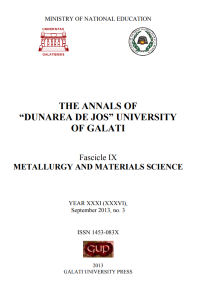Studies on the Effects of Olive Oil Oxidation
Abstract
The aim of this study is the viscosity’s evolution depending on the temperature and the shear rate and the analysis of the transmittance spectra of the oxidized olive oil. Oxidation of olive oil is a process that leads to the degradation of the sensorial qualities (color) and generates compounds such as peroxides and aldehydes. Studies performed in order to determine olive oil transmittance have shown that this method can be successfully used for the analysis of vegetable oils oxidation, oils that are going to be used as lubricants in food industry. Olive oil oxidation becomes more obvious by determination of trichromatic parameters. Thus it has been proved that by using this method, conclusive results regarding olive oil oxidation are obtained.
Downloads
References
[2]. Lambert, W.J., Johnson, I.J., Vegetable oil Lubricants for internal combustion engines and total loss lubrication, US Patent Nr. 5888947, (1999).
[3]. Paz, I., Molero, M., Journal. Am. Oil Chem. Soc, 77(2):127, (2000).
[4]. *** - CIE Technical Report: Colorimetry, 3rd ed., Publication 15, Central Bureau of the CIE, Vienna, (2004).
[5]. *** - CIE Technical Report: Improvement to Industrial Colour-Difference Evaluation, (2001).
[6]. *** - CIE Pub. No. 142, Vienna: Central Bureau of the CIE, (2001).
[7]. Zgherea, Gh., Analize Fizico – Chimice, Ed. Fd. Universitare “Dunărea de Jos” Galaţi, pp. 74-80, 88-94, (2002).
[8]. Florea, T., Creţu, R., Zgherea, Gh., Studiul afinităţii unor coloranţi alimentari faţă de fracţiile majore ale laptelui, Buletin de Informare Pentru Industria Laptelui (BIIL), Editura Academica, 19 (2), II, pp. 86-101, (2004).
[9]. Sancez-Gimeno, A.C., Negueruela, A.I., Benito, M., Vercet, A., Oria,R., Some physical changes in Banjo Aragon extra virgin olive oil during the frying process, Food Chemistry, No.110, pp. 654-658, (2008).
[10]. Gonnet, J. F. Colour effects of co-pigemntation of anthocyanin revisited, Analytical, Nutritional and Clinical Methods Section, Food Chemistry, 75, pp. 474, (2001).



